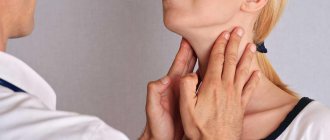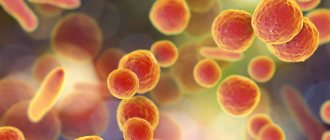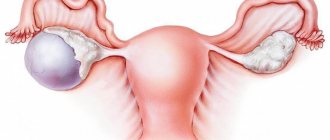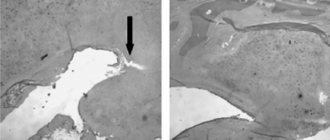Author of the article:
Soldatova Lyudmila Nikolaevna
Candidate of Medical Sciences, Professor of the Department of Clinical Dentistry of the St. Petersburg Medical and Social Institute, Chief Physician of the Alfa-Dent Dental Clinic, St. Petersburg
Candidiasis or, otherwise, thrush is an infectious disease, the main cause of which is infection with Candida fungi. These fungi belong to the same species as yeast and are part of the natural microflora of the vast majority of healthy people. The maximum concentration of these opportunistic microorganisms is observed in the intestines, nasopharynx, and vagina; Some fungi can also be found on the surface of the skin.
In a normal, healthy state of the body, the fungus does not cause any unpleasant symptoms. However, when the immune system is weakened and other provoking factors appear, Candida actively multiplies, resulting in discomfort, itching, burning and other manifestations of thrush. This disease can affect various tissues and organs; Candidiasis of the oral mucosa is also common.
Most often, infants suffer from this disease: according to statistics, up to 20 percent of children under the age of one year have suffered from candidiasis at least once. About 10 percent of people over 60 also suffer from symptoms of this infection. It occurs more often in women than in men; very often, signs of the disease appear in smokers. There are many other factors that contribute to the development of candidiasis in the mouth.
What is oral candidiasis?
Oral candidiasis (also called oral thrush) is an infection of the mouth caused by the yeast-like fungus Candida. These microorganisms are part of a healthy microflora, but under certain circumstances their reproduction disrupts the favorable environment and becomes a source of disease processes. Inflammation and plaque on the tongue, ulcers on the mucous membrane and discomfort in the mouth - this disease is called oral candidiasis.
Infants are most susceptible to this disease, but at this age it is treated faster and is tolerated almost painlessly. Oral thrush is often observed in adults after 50 years of age, when the immune system is already weakened. Oral candidiasis is less common in men than in women. Recently, the percentage of cases has increased significantly, which is associated with uncontrolled use of medications: weakening of cellular immunity increases the risk of oral candidiasis after antibiotics, or rather their improper use. Microbiology, the science of microorganisms, studies the essence of oral candidiasis. And she successfully copes with her task, at the moment this disease has been studied in detail, and doctors know all the methods of treating and preventing infection.
Pathogenesis
Normally, protection against mycotic (fungal) infection is provided by cellular immunity, namely the activity of T-lymphocytes and phagocytes (neutrophils, macrophages and monocytes). Phagocytic cells recognize, engulf and digest fungal cells. With a decrease in immunity and exposure to predisposing factors, phagocytes capture, but are not able to “digest” the fungus of the genus Candida - incomplete phagocytosis develops.
A disruption of the immune response leads to adhesion (attachment) of the fungus to the surface of the mucosa, and local inflammation occurs at this site. Candida then multiplies and penetrates the submucosa and other underlying tissues, disrupting their structure. Due to the presence of specific enzymes, Candida fungi are capable of causing tissue necrosis, which only enhances their adhesive properties and accelerates penetration.
Fungi of the genus Candida differ in their pathogenic activity depending on the species. Candida albicans is considered the most pathogenic, which is capable of changing its phenotype (as conditions for its habitat worsen, it changes from yeast to mold form), receptors and antigens.
Chronic candidiasis infection leads to sensitization (sensitivity) of the body to the fungal antigen and causes the formation of autoantibodies that destroy their own cells - the cells of the human body.
Causes of oral candidiasis
A healthy person is still a carrier of fungi of the genus Candida, since they are part of the microflora and calmly coexist with other microorganisms without causing harm. But any change in the balance in the body can lead to rapid proliferation of bacteria and the development of disease. A weakened state of immunity plays a key role in the etiology of oral candidiasis, but any of these reasons can be the starting point for the onset of the disease:
- pregnancy;
- immunodeficiency states;
- infectious processes;
- long-term treatment with antibiotics or improper use of medications;
- injuries and damage to the oral mucosa;
- insufficient oral hygiene;
- contact with an already sick person.
Disease prevention
Preventive measures are aimed at improving the condition of the microflora. These include:
- Proper oral hygiene.
- A thoughtful diet with a high amount of protein foods and reduced consumption of foods containing glucose.
- Quitting smoking and alcoholic beverages.
- Timely examination by the attending dentist for the prevention, diagnosis and treatment of the disease.
- Avoid taking medications, such as antibiotics, without first consulting your doctor.
- If the patient has dentures, then one of the preventive measures will be their regular treatment in a special solution.
Sources:
- The role of anti-inflammatory rinse in the treatment of periodontal diseases (L.Yu. Orekhova, A.A. Leontyev, S.B. Ulitovsky) L.Yu. OREKHOVA, Doctor of Medical Sciences, Prof., Head of Department; A.A. LEONTIEV, dentist; S.B. ULITOVSKY, Doctor of Medical Sciences, Prof. Department of Therapeutic Dentistry of St. Petersburg State Medical University named after. acad. I. P. Pavlova
- Report on clinical trials to determine/confirm the preventive properties of commercially produced personal oral hygiene products: mouth rinse "ASEPTA PARODONTAL" - Solution for irrigator." Doctor of Medical Sciences Professor, Honored Doctor of the Russian Federation, Head. Department of Preventive Dentistry S.B. Ulitovsky, doctor-researcher A.A. Leontiev First St. Petersburg State Medical University named after academician I.P. Pavlova, Department of Preventive Dentistry.
- Study of the clinical effectiveness of treatment and prophylactic agents of the Asepta line in the treatment of inflammatory periodontal diseases (A.I. Grudyanov, I.Yu. Aleksandrovskaya, V.Yu. Korzunina) A.I. GRUDYANOV, Doctor of Medical Sciences, Prof., Head of Department I.Yu. ALEXANDROVSKAYA, Ph.D. V.Yu. KORZUNINA, asp. Department of Periodontology, Central Research Institute of Dentistry and Maxillofacial Surgery, Rosmedtekhnologii, Moscow
Diagnosis of oral candidiasis
Candidiasis (thrush) of the oral cavity can be detected during an examination by a dentist if the patient has characteristic complaints. The doctor examines the condition of the oral mucosa, examines scrapings, and carefully examines the hair and skin. If you have oral candidiasis, you also need a blood test to check your glucose levels and rule out diabetes. The sooner you detect the presence of this infection, the easier it will be to get rid of it, so you should not delay diagnosis just because the symptoms do not cause you discomfort.
Diet for candidiasis in the mouth
Patients with oral candidiasis should change their diet by reducing the intake of simple carbohydrates. The latter include sugar, sweet fruits and berries, confectionery, honey, apples, grapes, white cabbage, legumes and drinks such as milk, kvass, and beer. This is due to the fact that yeast-like fungi can only use carbohydrates as food.
The second point is that you need to increase the amount of foods consumed that can suppress the development of Candida. The growth of fungi can be controlled by natural yoghurts containing live lactic acid cultures, as well as products with natural antifungal activity (garlic, propolis, hot red pepper).
Symptoms of oral candidiasis
- Infection is characterized by the appearance of swelling and a whitish coating on the mucous membranes of the cheeks, lips, and tongue. When the plaque is removed, the surface bleeds, and the patient experiences a burning sensation.
- With oral candidiasis, the tongue and throat become sensitive, and any contact is painful for the patient.
- Signs of oral candidiasis also include cracks in the corners of the lips and redness of the mucous membrane.
- Symptoms of oral thrush include severe dry mouth, a feeling of tightness of the mucous membrane, and roughness of the internal surfaces.
- Patients often complain of increased temperature due to oral candidiasis. Sometimes this disease is accompanied by the appearance of small ulcers on the inside of the lip and cheek mucosa, which are filled with pus and emit a characteristic odor of oral candidiasis.
Signs of oral candidiasis in HIV diseases are slightly different from traditional ones. In this case, the infection spreads quickly and immediately becomes acute, and plaques and plaque appear not only in the mouth, but also in the genital area. With HIV, thrush of the oral mucosa is difficult to treat, so even with minor symptoms it is better to visit a doctor and check your health.
Classification of oral candidiasis
This disease is usually divided into several types, each of which has its own characteristic features. Experts distinguish between acute and chronic oral candidiasis.
Acute pseudomembranous candidiasis
Characteristic of infants with weakened immunity. Oral candidiasis, or oral candidiasis, can be triggered by a previous infectious disease or gastrointestinal disorder. The disease is transmitted through a pacifier or dishes; the disease manifests itself in the form of a light or grayish coating on the mucous membrane. At the initial stage, plaque is painlessly removed; with the development of candidiasis of the oral mucosa and pharynx, it thickens and spreads in the oral cavity. It is almost impossible to remove plaque on the tongue without causing bleeding.
Acute atrophic candidal stomatitis
Accompanied by peeling of the integument, dryness and burning of the mucous membrane, it is painful for the patient to eat and touch the infected area. With this form of oral candidiasis, the infection can spread further - to the larynx, pharynx and even the esophagus.
Chronic hyperplastic candidiasis of the oral cavity
It is characterized by a change from a whitish coating to a grayish-yellow one, after removal of which slight bleeding occurs. Along with plaque, plaques and thickenings appear that cannot be cleaned off or removed; they go away on their own during the treatment process.
Chronic atrophic candidiasis of the oral cavity
It is diagnosed when inflammation spreads to the skin and cracks appear in the corners of the mouth. In this case, the tongue becomes a shiny, rich pink color, and the vessels are clearly visible on it. Then the infection spreads to the internal organs. This type of oral candidiasis can occur due to improper installation of dentures, plates and crowns, which rub and injure the mucous membrane.
How to treat candidiasis in the mouth -
The article is for informational purposes only, and we urge you not to self-medicate, despite the fact that some antifungal drugs are still available over the counter. You need to start with a microbiological study, and also a test for HIV infection.
Microbiological test - before starting to take antifungal drugs, it is very important to perform a microbiological test (culture of material from your oral cavity - identifying the amount of Candida, as well as determining the sensitivity of Candida to the main antifungal drugs). Please note that the analysis must include not only sensitivity to drugs, but also the number of Candida fungi.
The latter will make it possible to distinguish acute or chronic fungal infection from a banal carriage and, thus, confirm the diagnosis. Different laboratories may use different methods to determine antifungal susceptibility. The cheapest and most inaccurate is a Russian-made test that determines sensitivity to 6 antifungal drugs using the disk diffusion method (using disks produced by the Scientific Research Center for Physics, Russia). It is best if sensitivity to drugs is analyzed on a VITEK analyzer, France.
Treatment of oral candidiasis takes an average of 12-15 days (until the symptoms of the disease completely disappear). However, in patients with chronic candidiasis who have already had repeated relapses, maintenance courses of therapy will also be required. In case of a widespread process, treatment of the disease should be carried out by a dentist - in collaboration with doctors of other specialties (general practitioner, gynecologist, mycologist).
1) Local treatment for mild primary form of the disease -
Abroad, there are a large number of drugs for the treatment of mild forms of oral candidiasis, intended for local use in the oral cavity. These are special mucoadhesive tablets with Miconazole 50 mg, which are taken only once a day. These are lozenges with Clotrimazole 10 mg, which dissolve in the mouth in about 20 minutes and should be taken 5 times a day. This is a special oral suspension of Nystatin 100,000 Units/ml, which is taken 5 ml 4 times a day (this suspension is kept in the mouth for several minutes and then swallowed).
But all these drugs are not available in Russia (although some of them will be available to you, for example, if you live in Ukraine). But let's look at what is available to residents of Russia, and we'll start with the simplest.
1) The first option is tablets with Nystatin, 500,000 units, which can be used for resorption - 1 tablet. 4 times a day, i.e. approximately every 6 hours. For children, a single dosage will be 125 thousand units or 250 thousand units, depending on age, and the dosage regimen will be similar. Nystatin is not absorbed through the oral mucosa and into the gastrointestinal tract, but has an unpleasant taste and can occasionally cause nausea, vomiting and diarrhea. Additionally, this is a prescription drug and should only be used as directed by a doctor.
2) Another antifungal drug for topical use in the oral cavity is Amphotericin B, which is sold in 50 mg bottles (for suspension). This drug is a more effective analogue of nystatin. It is usually used for intravenous administration in severe systemic forms of candidiasis. However, there is a large number of studies, as well as clinical practice, when the suspension was used for use in the oral cavity. It must be said that “Amphotericin B” (as well as Nystatin) is practically not absorbed into the gastrointestinal tract or through the oral mucosa. The suspension is used 3 times a day (each time a 50 mg bottle is diluted with 5 ml of solution). Remember that this is also a prescription drug and should only be used as directed by a doctor.
3) Probably the best option is the drug “Diflucan powder”, which contains fluconazole and is intended for preparing a suspension. After dilution, 1 ml of suspension will contain 10 mg of fluconazole. For erythematous (atrophic) form of candidiasis, you need to use 50 mg 1 time per day for 7-14 days, but for pseudomembranous or hyperplastic candidiasis, the dosage is already 100 mg 1 time per day. The suspension should be kept in the mouth for a few minutes (rinse) and then swallowed. One bottle costs from 500 rubles, and is enough for 7 applications of 50 mg each.
Provided that the patient's Candida fungi are equally sensitive to all 3 drugs, a fluconazole suspension will be more effective than nystatin (since the latter has poor adhesion to the oral mucosa), and show the same effectiveness as an Amphotericin suspension. Please note that Diflucan powder for suspension is also only a prescription drug that is not intended for self-medication and should be used only as prescribed by a doctor.
Additional local therapy –
As additional local therapy, solutions for rinsing the oral cavity, as well as antifungal drugs in the form of gels (for application to the affected areas of the oral mucosa) can be used.
- best of all is an antiseptic solution of Chlorhexidine 0.2%,
- Warm soda rinses can also have a weak effect,
- gel with miconazole (for applications to the oral mucosa).
Moreover, the use of the antiseptic Chlorhexidine in addition to therapy with antifungal agents is strongly recommended for the development of candidiasis while wearing removable dentures, as well as against the background of poor oral hygiene.
2) Systemic therapy for moderate and severe oral candidiasis -
The first line of treatment for oral thrush in adults (for moderate to severe oral candidiasis) is fluconazole tablets. It has the advantage that, unlike nystatin and amphoterecin, firstly, it is well absorbed in the intestine, and secondly, it penetrates into saliva in large quantities. Before starting to take the drug or in the first days of taking it, it is very important to consult a dentist and remove all supra- and subgingival dental plaque, which, among other things, is a reservoir of Candida fungi in the oral cavity.
The same applies to patients with removable dentures, who will also need to undergo ultrasonic cleaning of the remaining teeth, as well as professional disinfection of the denture. What else is important to know. We have already said above that fungi of the genus Candida quite often demonstrate resistance to fluconazole (especially in patients with repeated relapses of thrush). For example, while Candida albicans shows good sensitivity to fluconazole, the fungal species C. glabrata and C. krusei show resistance in approximately 35% and 75% of cases, respectively.
Therefore, fluconazole therapy should be started only after a microbiological examination - culture of material from your oral cavity and identification of the sensitivity of the fungal flora to the main antifungal drugs. If the study shows the sensitivity of your Candida fungi to fluconazole, it is taken in a dosage of 150 mg 1 time per day (treatment course is 7-14 days). If we are talking about treating another relapse of oral candidiasis, then suppressive therapy will also be required. This means after completing the main course of treatment, you will have to continue taking fluconazole 100 mg 3 times a week. The duration of the course of suppressive therapy is determined by the doctor.
If Candida is resistant to fluconazole –
In case of insensitivity to fluconazole, Itraconazole capsules are first prescribed (taken only as prescribed by a doctor - usually 200 mg once a day, duration of therapy is usually 28 days). This is a prescription drug that, due to side effects, is not suitable for self-medication and should therefore only be used when prescribed by a doctor. Other drugs that can be used for fluconazole resistance include Voriconazole, Posaconazole, and Isavuconazole.
By the way, the basic dosage of 100 mg per day prescribed in the instructions for Itraconazole is much less effective than a dosage of 200 mg per day. This is confirmed by clinical studies, and this is especially true for patients with weakened immune systems and in the presence of aggressive subspecies of fungi of the genus Candida - such as C.glabrata and C.krusei. The same applies to the duration of use. For example, the instructions for intraconazole only say about 15 days of therapy (and not 28 days), but in case of weakened immunity, or in the presence of aggressive strains of Candida, such a duration of treatment is highly likely to lead to the development of relapses of candidiasis in the near future.
Table 1 - “Resistance of antifungal drugs to different types of fungi of the genus Candida.”
Treatment of oral thrush
The treatment of this disease is carried out by the dentist, although he may seek advice from a therapist, immunologist or endocrinologist. To get rid of this disease, there are many medications, from which a specialist will choose the one that is right for you. Do not forget that different medications are used to treat oral candidiasis in adults and children. Also, to speed up recovery, you should follow a special diet that your doctor will prescribe; it is important for restoring the mucous membranes after candidiasis of the mouth and throat. Many patients neglect visiting a specialist and prefer advice from those who have already encountered this infection, as well as traditional methods. Such behavior is extremely dangerous; oral candidiasis cannot be treated based on reviews on forums or recommendations from friends. This can provoke unforeseen complications and cause serious harm to health. The doctor will accurately determine the cause of your disease and prescribe a drug that is suitable for your physiological characteristics. Read more about the treatment of oral candidiasis in the article.
Symptoms and signs of the disease
Candidiasis develops gradually and is characterized by the following symptoms:
- burning in the mouth;
- discomfort while eating;
- the appearance of a white coating on the tongue;
- white spots throughout the mucous membrane;
- constant dryness.
If one of the symptoms occurs, you should consult a dentist or infectious disease specialist to determine a diagnosis. It is important that plaque, dryness and growths can also occur with bacterial diseases, which are treated differently. Therapy must be prescribed immediately, because the fungus becomes a cause for the development of other diseases.
Prevention of oral candidiasis
The occurrence of this disease is a very unpleasant and painful phenomenon, fortunately, it is quite easy to avoid by following the recommendations. One of the main causes of infection is weakened immunity, so the basic rule for preventing the disease is to treat any disease at the right time and take medications strictly as prescribed by the doctor. To avoid candidiasis of the oral cavity, pharynx and larynx, hygiene, visiting a good dentist, professional ultrasonic cleaning and other preventive measures will help. Oral candidiasis in women is often due to hormonal imbalance; if you have symptoms of the disease, you should pay attention not only to the affected area, but also to the condition of the body as a whole.
Consultation with a therapist or dentist
If you suspect that you have an oral disease that requires medical supervision, make a list of all the symptoms you have, including those that may seem unrelated to thrush: the doctor will understand whether they are important or not. Include non-medical factors in this list, such as increased stress levels and causes of anxiety. Indicate whether you are around people with weakened immune systems.
You will also need to prepare a list of all medications you take. Also, write down questions you want to ask your doctor. This will help you find out all the details you are interested in and get a comprehensive consultation, regardless of whether you have oral candidiasis or not.
The doctor may ask you clarifying questions that will allow him to narrow down the search for a diagnosis based on the symptoms he has identified and the symptoms you describe. Try to answer as openly and honestly as possible so that the doctor can quickly diagnose the disease and begin treatment without waiting for complications.
If an examination of the oral cavity does not allow the doctor to make an accurate diagnosis, he will definitely take a small sample and either examine it himself or send it to a laboratory for analysis.
If the infection has already affected not only the oral cavity, but also the esophagus, a couple of studies may be required. First, your doctor will take a swab from the back of your throat to determine what bacteria or fungi are causing your symptoms. You may then have an endoscopic examination, in which your doctor uses an endoscope (a flexible tube with a light) to look at your esophagus, stomach, and upper small intestine. This will determine how far the infection has spread.








